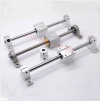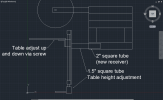- Joined
- May 23, 2017
- Messages
- 1,268
One thing I'll clarify on my earlier statement where it takes a couple hundred knives to be "good" at freehand grinding, is there are different levels of being able to do it.
After 10-20 knives (especially with some hands on instruction) you should be able tk grind good functional knives, but there will still be a lot of things that are challenging or you have yet to figure out.
The couple hundred I threw out was what I consider to be "good". Basic knives are easy and relitivly fast, and pretty well any shape or grind is doable, but it still involves slowing down and taking your time on more complicated pieces.
Now I haven't gotten here yet so there is some level of speculation and looking at/talking to other makers involved, but the 1000+ mark (or wherever exactly it ends up being for you) is the point where you actually master it. People like Egnath, Shore, Hibben, Warenski, ect (far from an inclusive list, just the first 4 that came to mind) who could grind blades in their sleep.
I'm about at the 400 mark. I can do pretty well any grind or blade style I'd want to, I'm just slow with more complicated ones. A basic hunting knife might take 10 minutes, whereas a dagger or double edge fighter might take me a couple hours.
We all start at the bottom, it just depends how much time and effort you want to put into climbing the ladder.
After 10-20 knives (especially with some hands on instruction) you should be able tk grind good functional knives, but there will still be a lot of things that are challenging or you have yet to figure out.
The couple hundred I threw out was what I consider to be "good". Basic knives are easy and relitivly fast, and pretty well any shape or grind is doable, but it still involves slowing down and taking your time on more complicated pieces.
Now I haven't gotten here yet so there is some level of speculation and looking at/talking to other makers involved, but the 1000+ mark (or wherever exactly it ends up being for you) is the point where you actually master it. People like Egnath, Shore, Hibben, Warenski, ect (far from an inclusive list, just the first 4 that came to mind) who could grind blades in their sleep.
I'm about at the 400 mark. I can do pretty well any grind or blade style I'd want to, I'm just slow with more complicated ones. A basic hunting knife might take 10 minutes, whereas a dagger or double edge fighter might take me a couple hours.
We all start at the bottom, it just depends how much time and effort you want to put into climbing the ladder.




